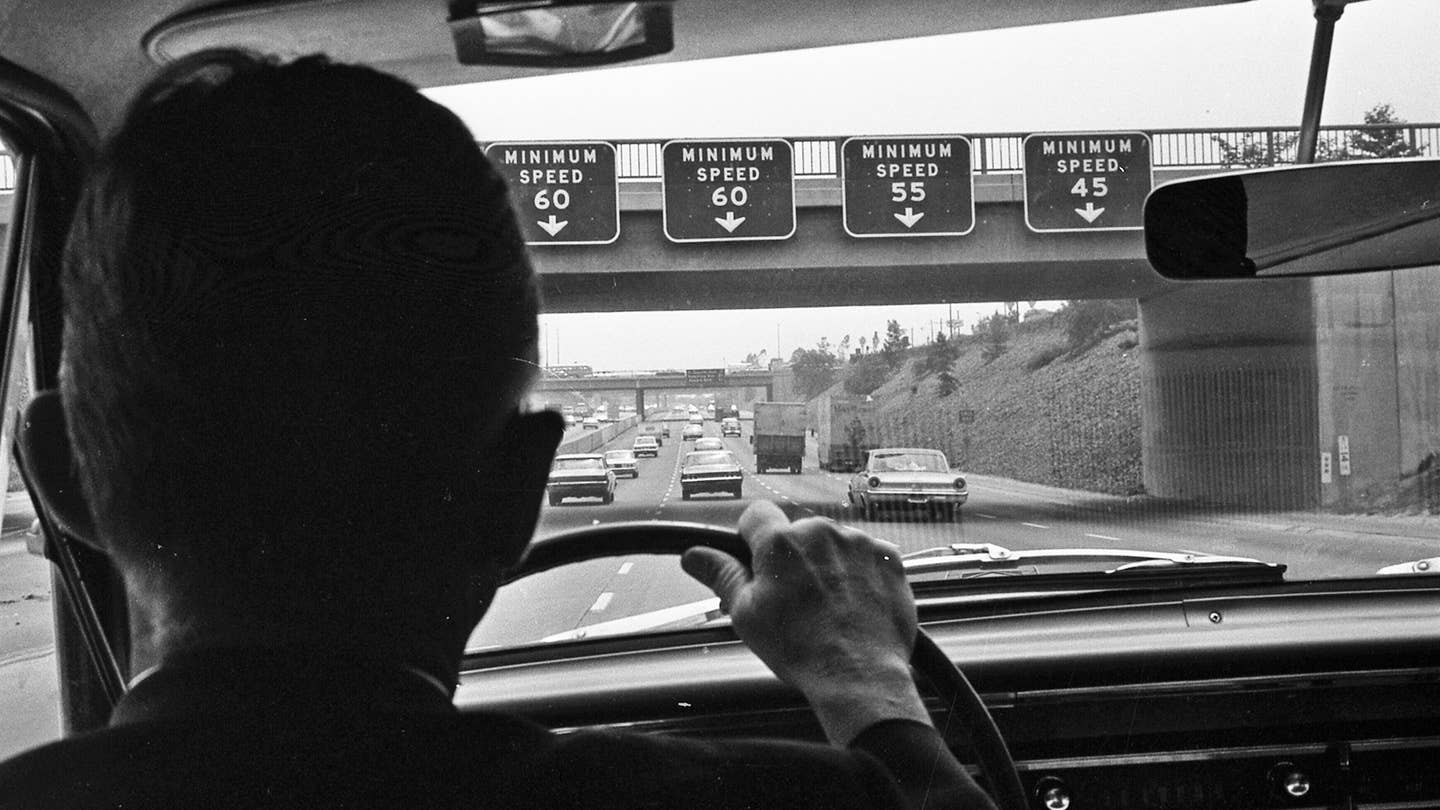Different minimum speeds for slow and fast lanes seems smart, but a test run in California showed it doesn’t work in the real world.

The feeling when you’re caught behind a slow driver in the left lane—your gaze boring into their taillights, trying to will them to get out of the way—is a universal one. It’s also been a problem since the advent of the highway system nearly 70 years ago. You could argue the real solution is driver education. Or, you could try what California did back in 1966 and experiment with enforcing lane-specific speed minimums: 60 mph for the left lane, 55 mph for the middle ones, and 45 mph for the slowpokes on the right.
Rewind to 1959: Los Angeles’ freeway system was rapidly expanding into the tangled sprawl it’s known for today. These multilane arteries were still new and unfamiliar to many motorists, who were also getting used to the higher speeds. As a result, too-slow drivers bunching up traffic became a real enough issue that California Assemblyman Lee M. Backstrand of Riverside introduced legislation in February of that year to provide minimum speed limits on California highways.
With a rather combative statement to the Los Angeles Times, Backstrand wanted to let the “guy who pokes along in the fast lane know that he’s as dangerous as the fast driver.” By April his proposal was overwhelmingly approved by 69-1, which authorized the then-called State Division of Highways (now known as Caltrans) to post safe minimum speed limits on individual freeway lanes based on traffic surveys.
Los Angeles Times
The gears began turning, with a 1965 Division of Highways feasibility study identifying the Harbor Freeway in LA, now known as the SR-110, as an ideal testing ground. A year later, per-lane minimum speed signs appeared on a three-mile, four-lane segment of the highway for a one month trial, according to the corresponding edition of the LA Times.
During the test, a special Division of Highways van was posted nearby monitoring the speed of traffic in each lane, and the LAPD who were patrolling the segment would cite drivers driving below the minimum speed. Based on a 1965 amendment to the California Vehicle Code, which came from efforts starting in 1959, said that drivers with five or more cars behind them must get out of the way or face a citation. The code went as far as saying that drivers should pull off of the road to allow cars by. This rule actually stands to this day—looking at you, California drivers.
Similar tests were being run in the northern California cities of Stockton, Marysville, and San Francisco. It all went relatively smoothly, and the results were compiled into a 15-page report presented at the 47th annual meeting of the Committee of Freeway Operations a year later. The only problem? It didn’t work.
The minimum speed by lane system “showed little or no positive advantages and showed some definite disadvantages,” according to the report. It actually did the complete opposite of decongesting the left lane: “The most unanticipated result of this study was the fact that the minimum speed signing generally moved more drivers into the left lanes instead of moving slow drivers to the right lane.”
The police found the minimum speeds to be essentially unenforceable, observing that drivers were passing more on the right, that a quarter of all motorists didn’t even notice the signs, and that 13% of citations issued for minimum speed violations indicated that drivers confused “minimum” for “maximum.”
“In conclusion,” the report reads, ”minimum speed by lane signs would only add clutter to the highways.”
Though there are overall minimum speed limits for many highways, the idea of lane-specific ones hasn’t returned to our highways. In their place, “Slower Traffic Keep Right” have tried to do the job for far less cost and distraction, though the lack of lane discipline in this country persists. Maybe one day we’ll figure it out.

